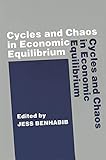Cycles and Chaos in Economic Equilibrium / Jess Benhabib.
Material type: TextPublisher: Princeton, NJ : Princeton University Press, [2022]Copyright date: ©1992Description: 1 online resource (487 p.)Content type:
TextPublisher: Princeton, NJ : Princeton University Press, [2022]Copyright date: ©1992Description: 1 online resource (487 p.)Content type: - 9780691225210
- Business cycles -- Mathematical models
- Equilibrium (Economics) -- Mathematical models
- BUSINESS & ECONOMICS / Economics / General
- "economic literature
- ARCH Models
- Aperiodic dynamics
- Behavioral Assumptions
- Bifurcation
- Clearing Theories
- Consumption loans
- Cyclic Sets
- Diagrammatic Exposition
- Economic Data
- Equilibria
- Final remarks
- Foresight Dynamics
- Indeterminacy
- Money Transfers
- Monotonicity
- Multiplicity
- Notations
- Saddle-Point Instability
- Samuelson Economy
- Sarkovskii's theorem
- Stability
- Stabilization Policies
- The Model
- The Technology
- Topological conjugacy
- Two-Sector Economy
- Uniqueness
- Volatility"
- Wealth-Capital Economy
- chaotic
- dynamic programming
- dynamically
- endogenous cycles
- erratic
- estimation
- intertemporal
- mechanisms
- oscillatory
- stochastic non-linearity
- turnpike property
- 339.5 23
- HB3711
- online - DeGruyter
| Item type | Current library | Call number | URL | Status | Notes | Barcode | |
|---|---|---|---|---|---|---|---|
 eBook
eBook
|
Biblioteca "Angelicum" Pont. Univ. S.Tommaso d'Aquino Nuvola online | online - DeGruyter (Browse shelf(Opens below)) | Online access | Not for loan (Accesso limitato) | Accesso per gli utenti autorizzati / Access for authorized users | (dgr)9780691225210 |
Frontmatter -- Contents -- Introduction -- 1 Equilibrium Models Displaying Endogenous Fluctuations and Chaos: A Survey -- 2 Periodic and Aperiodic Behaviour in Discrete One-Dimensional Dynamical Systems -- 3 A Characterization of Erratic Dynamics in the Overlapping Generations Model -- 4 On Endogenous Competitive Business Cycles -- 5 Competitive Business Cycles in an Overlapping Generations Economy with Productive Investment -- 6 Endogenous Fluctuations in a Two-Sector Overlapping Generations Economy -- 7 Recent Theories of the Business Cycle: The Role of Speculative Inventories -- 8 Endogenous Cycles with Uncertain Lifespans in Continuous Time -- 9 The Hopf Bifurcation and the Existence and Stability of Closed Orbits in Multisector Models of Optimal Economic Growth -- 10 Sources of Complex Dynamics in Two-Sector Growth Models -- 11 Imperfect Financial Intermediation and Complex Dynamics -- 12 Dynamical Systems that Solve Continuous-Time Concave Optimization Problems: Anything Goes -- 13 Stochastic Equilibrium Oscillations -- 14 Cyclical and Chaotic Behavior in a Dynamic Equilibrium Model, with Implications for Fiscal Policy -- 15 Endogenous Business Cycles with Self-Fulfilling Optimism: A Model with Entry -- 16 Keynesian Chaos -- 17 Feedback Between R&D and Productivity Growth: A Chaos Model -- 18 Is the Business Cycle Characterized by Deterministic Chaos? -- 19 The Statistical Properties of Dimension Calculations Using Small Data Sets: Some Economic Applications -- 20 Some Evidence on the Non-Linearity of Economic Time Series: 1890-1981 -- 21 Nonlinear Dynamics and Stock Returns -- List of Contributors
restricted access online access with authorization star
http://purl.org/coar/access_right/c_16ec
In recent years economists have begun to use the techniques of non-linear dynamics to show that some apparently erratic and turbulent economic phenomena reflect subtle underlying patterns. How do cyclic and chaotic dynamics arise in economic models of equilibrium? How can empirical methods be used to detect nonlinearities and cyclic and chaotic structures in economic models? In examining these questions, this book brings together the most significant work that has been done to date in economics-based chaos theory. Selected here particularly for the economist who is not a specialist in chaos theory, the essays, some previously unpublished and others not widely available, describe a new tool for understanding business cycles, stabilization policy, and forecasting. The contributors to the volume are William J. Baumol, Jess Benhabib, Michele Boldrin, William A. Brock, Richard H. Day, Raymond J. Deneckere, Allan Drazen, Jean-Michel Grandmont, Kenneth L. Judd, Bruno Jullien, Guy Laroque, Blake LeBaron, Bruce McNevin, Luigi Montrucchio, Salih Nefti, Kazuo Nishimura, James B. Ramsey, Pietro Reichlin, Philip Rothman, Chera L. Sayers, Jos A. Scheinkman, Wayne Shafer, William Whitesell, Edward N. Wolff, and Michael Woodford.
Mode of access: Internet via World Wide Web.
In English.
Description based on online resource; title from PDF title page (publisher's Web site, viewed 29. Jul 2022)


